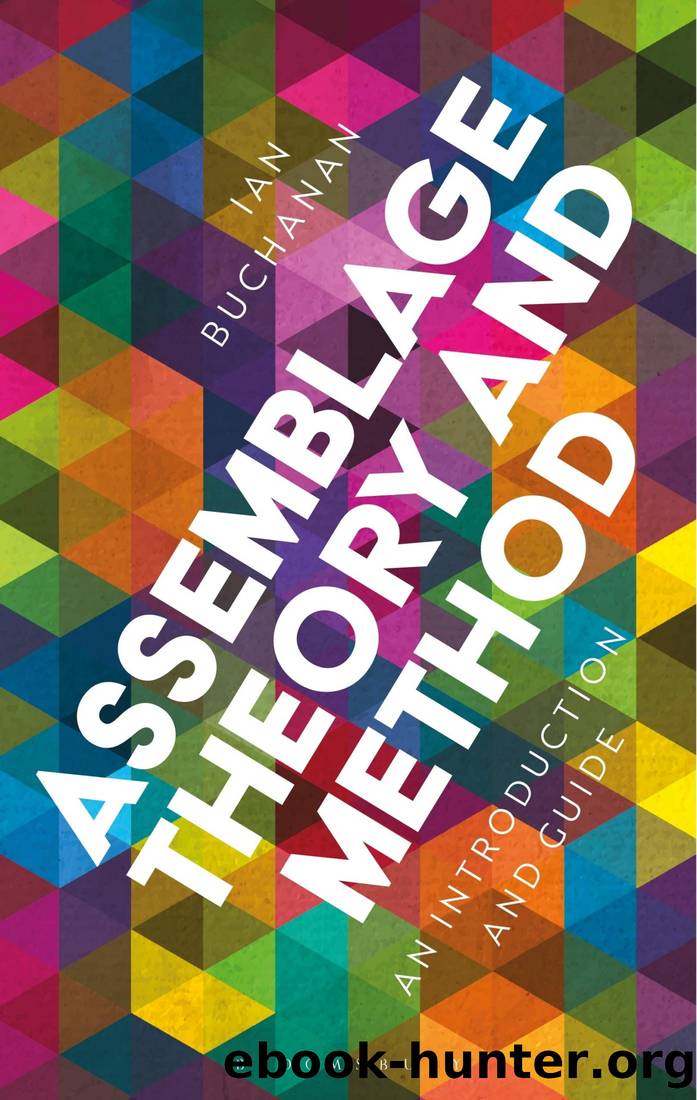Assemblage Theory and Method by Ian Buchanan

Author:Ian Buchanan [Buchanan, Ian]
Language: eng
Format: epub
Tags: Philosophy, Political, Political Science, History & Theory, Social, Social Science, Human Geography, education, General, Metaphysics
ISBN: 9781350015555
Google: HFXuDwAAQBAJ
Amazon: 1350015555
Publisher: Bloomsbury Academic
Published: 2020-09-03T00:00:00+00:00
3
Territory
The key to understanding the concept of territory is chaos defined as an existential condition rather than a physical state of affairs (though it can be that too). This is ground zero for schizoanalysis. We see this very clearly in the chapter on the refrain in A Thousand Plateaus, which, despite its title, is really about the concept of territory. In a nice turn of phrase, Elizabeth Grosz defines the refrain as a âkind of rhythmic regularity that brings a minimum of liveable order to a situation in which chaos beckons.â1 Grosz does not expand on the phrase âliveable orderâ herself, but in what follows I will try to expand upon it as a way of understanding territory. Territory is a liveable order produced and sustained by a refrain. For Deleuze and Guattari, chaos is an ever-present potentiality in both our mental lives and the physical world. All that we have, and all that we are, even the most stratified aspects of our lives, is nothing but a temporary victory over the relentless forces of chaos which are like a ground bass to our very existence. Deleuze and Guattari conceive chaos as both the absolute foundation for all thinking (it is the beginning and end of thought) and as a kind of relative dissolution of the senses and the sensible. It is, in other words, an ever-present possibility but one that is only realized in particular sets of circumstances. But it is never far away. It can never be entirely forgotten or ignored. Deleuze and Guattari speak of chaos threatening, stalking and trying to reabsorb the hard won sensibility of the concept.2 But, even though they often speak of chaos as something to fear, and to ward off, they are equally adamant that without it, at least a bit of it, we would stultify and die. Chaos is both life and death. In What is Philosophy?, a book that is essentially organized around the notion of chaos, Deleuze and Guattari depict the disciplines of art, philosophy and science as being locked into an ageless battle against chaos. Each one fights chaos in its own way, but chaos is nevertheless the constant enemy. However, the aim of these battles is never to win completely, to shut out chaos altogether, because to do that would be to induce creative stasis â a form of death-in-life. The artist has to confront chaos and let it in and then try to give it form.
Chaos is not an inert or stationary state, nor is it a chance mixture. Chaos makes chaotic and undoes every consistency in the infinite. The problem of philosophy [we could also say of life itself] is to acquire consistency without losing the infinite into which thought plunges (in this respect chaos has as much a mental as physical existence).3
There is, however, an art of dosages when it comes to chaos: one needs chaos, but only so much and not too much â just enough to disrupt ânormal serviceâ so to speak and allow creativity to flow.
Download
This site does not store any files on its server. We only index and link to content provided by other sites. Please contact the content providers to delete copyright contents if any and email us, we'll remove relevant links or contents immediately.
The remains of the day by Kazuo Ishiguro(7550)
Tools of Titans by Timothy Ferriss(6945)
The Black Swan by Nassim Nicholas Taleb(6190)
Inner Engineering: A Yogi's Guide to Joy by Sadhguru(5894)
Giovanni's Room by James Baldwin(5877)
The Way of Zen by Alan W. Watts(5798)
The Six Wives Of Henry VIII (WOMEN IN HISTORY) by Fraser Antonia(4789)
The Power of Now: A Guide to Spiritual Enlightenment by Eckhart Tolle(4753)
Astrophysics for People in a Hurry by Neil DeGrasse Tyson(4619)
Asking the Right Questions: A Guide to Critical Thinking by M. Neil Browne & Stuart M. Keeley(4574)
12 Rules for Life by Jordan B. Peterson(3733)
The Ethical Slut by Janet W. Hardy(3502)
Skin in the Game by Nassim Nicholas Taleb(3459)
Housekeeping by Marilynne Robinson(3401)
The Art of Happiness by The Dalai Lama(3382)
Double Down (Diary of a Wimpy Kid Book 11) by Jeff Kinney(3272)
Skin in the Game: Hidden Asymmetries in Daily Life by Nassim Nicholas Taleb(3264)
Walking by Henry David Thoreau(3234)
12 Rules for Life: An Antidote to Chaos by Jordan B. Peterson(3200)
